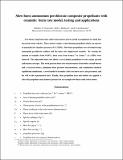| dc.contributor.author | Vernacchia, Matthew T. | |
| dc.contributor.author | Mathesius, Kelly J. | |
| dc.contributor.author | Hansman Jr, Robert J | |
| dc.date.accessioned | 2021-06-15T18:18:27Z | |
| dc.date.available | 2021-06-15T18:18:27Z | |
| dc.date.issued | 2021-06 | |
| dc.date.submitted | 2020-05 | |
| dc.identifier.issn | 1533-3876 | |
| dc.identifier.uri | https://hdl.handle.net/1721.1/130944 | |
| dc.description.abstract | Low-thrust long-burn-time solid rocket motors may be useful as propulsion for small, fast, uncrewed aerial vehicles. These motors require a slow-burning propellant that can operate at unusually low chamber pressures (0.3–2 MPa). Slow-burn propellants were developed using ammonium perchlorate oxidizer and the burn rate suppressant oxamide. By varying the amount of oxamide (from 0 to 20%), burn rates from 4 to 1 mm⋅s−1 (at 1 MPa) were achieved. The adjustable burn rate allows a set of similar propellants to serve many aircraft and mission concepts. This work presents burn rate measurements (from both a strand burner and a research motor), minimum burn pressure measurements, and combustion chemical equilibrium simulations. A novel model of oxamide’s effect on burn rate is also presented, and it fits well to the experimental data. Finally, these propellant data and models are applied to select the propellant and chamber pressure for an example low-thrust solid rocket motor. | en_US |
| dc.publisher | American Institute of Aeronautics and Astronautics (AIAA) | en_US |
| dc.relation.isversionof | http://dx.doi.org/10.2514/1.b38106 | en_US |
| dc.rights | Creative Commons Attribution-Noncommercial-Share Alike | en_US |
| dc.rights.uri | http://creativecommons.org/licenses/by-nc-sa/4.0/ | en_US |
| dc.source | Matthew Vernacchia | en_US |
| dc.title | Slow-Burn Ammonium Perchlorate Propellants with Oxamide: Burn Rate Model, Testing, and Applications | en_US |
| dc.type | Article | en_US |
| dc.identifier.citation | Vernacchia, Matthew T. et al. "Slow-Burn Ammonium Perchlorate Propellants with Oxamide: Burn Rate Model, Testing, and Applications." Journal or Propulsion and Power (June 2021): doi.org/10.2514/1.B38106. © 2021 The Authors | en_US |
| dc.contributor.department | Massachusetts Institute of Technology. Department of Aeronautics and Astronautics | en_US |
| dc.relation.journal | Journal or Propulsion and Power | en_US |
| dc.eprint.version | Author's final manuscript | en_US |
| dc.type.uri | http://purl.org/eprint/type/JournalArticle | en_US |
| eprint.status | http://purl.org/eprint/status/PeerReviewed | en_US |
| dspace.date.submission | 2021-06-10T16:43:11Z | |
| mit.license | OPEN_ACCESS_POLICY | |
| mit.metadata.status | Complete | |
